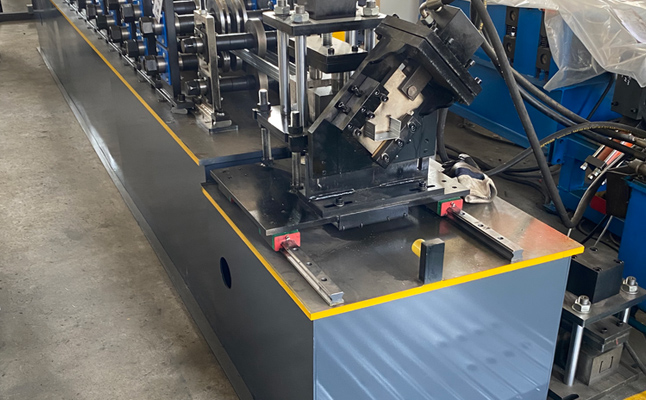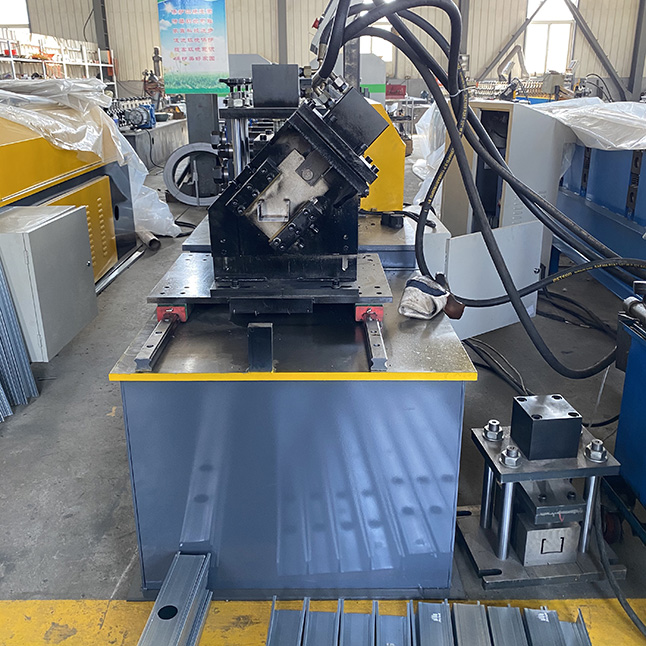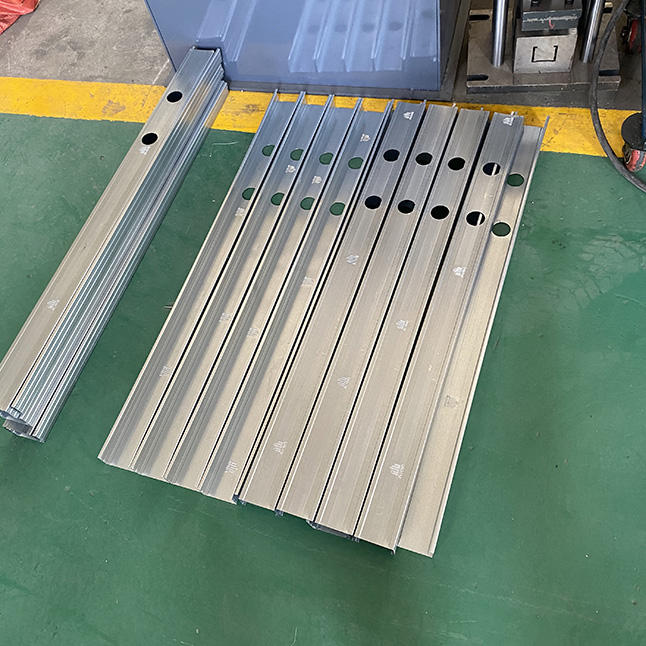
TAG: Light Steel Keel Rolling Machine Light Steel Keel Roll Machine Light Steel Keel Roll Forming Machine
Price:
Detailed Introduction

The ceiling keel machine is a device used to produce ceiling keels. The following is a detailed introduction:
Structural composition
Unloading machine: used to place and convey metal coils, such as steel strips, aluminum plates, etc., usually equipped with a brake device and a tension control system to ensure the stability and tension uniformity of the coils during the conveying process.
Guide frame: straighten and guide the metal strip entering the forming main machine to ensure the flatness and entry angle of the strip, and reduce deviation and deformation during the forming process.
Forming main machine: the core part, composed of multiple rollers and molds, drives the rollers to rotate through the motor drive and transmission system, and gradually bends and forms the metal strip into the required keel shape.
Correction device: further corrects and adjusts the formed keel to ensure the dimensional accuracy and shape accuracy of the keel and improve product quality.
Size cutting part: cut the formed keel according to the set length requirements, and hydraulic shearing, mechanical shearing and other methods can be used to ensure the flatness of the cutting surface and the accuracy of the size.
Receiving table: used to collect the cut keels, convenient for sorting and handling, and can be designed into the form of automatic stacking or manual handling as needed.
Electrical control part: adopt PLC or industrial computer control to realize automatic operation and precise control of the equipment, including the setting and monitoring of parameters such as production speed, cutting length, roller adjustment, etc., and also has fault diagnosis and alarm functions.
Working principle
During operation, the metal coil is installed on the unloading machine, and the metal strip is introduced into the forming main machine through the guide frame. In the forming main machine, the metal strip is gradually bent and formed according to the pre-designed mold shape under the action of a series of rollers to form the required keel shape. The formed keel continues to be conveyed forward, further adjusted and calibrated by the correction device, and then reaches the fixed length cutting part and cut according to the set length. Finally, the cut keel is conveyed to the receiving table for collection and sorting.
Features
High production efficiency: adopts advanced transmission system and automatic control technology, fast production speed, and can meet the needs of large-scale production. For example, the working speed of high-speed C-type keel machine can reach 70 meters per minute.
High product precision: Equipped with precise rollers and molds, as well as advanced control systems, it can ensure the dimensional accuracy and shape accuracy of the keel, and improve the installation quality and aesthetics of the ceiling.
Easy operation: The structure is relatively simple and easy to operate. Operators who have undergone simple training can operate it proficiently. At the same time, the control system has a good human-machine interface, which is convenient for parameter setting and equipment monitoring.
Wide range of applications: By replacing different rollers and molds, ceiling keels of various shapes and specifications can be produced, such as V-shaped, C-shaped, T-shaped, L-shaped, U-shaped keels, etc., and special shapes of keels can be customized according to customer needs to meet the needs of different architectural decorations.
Stable and reliable quality: The equipment adopts high-quality materials and advanced manufacturing processes, has high strength and rigidity, can operate stably for a long time, and ensures the stability of product quality.
Environmental protection and energy saving: The noise generated during operation is low, and the use of energy-saving motors and optimized transmission systems reduces energy consumption, which meets the requirements of environmental protection and energy saving.
Technical parameters
Rolling capacity: Generally, plates with a width of less than or equal to 150mm can be rolled, and the plate thickness is usually between 0.6-2.0mm.
Production speed: usually around 6-13 meters per minute, the specific speed depends on the model, power of the equipment and the complexity of the keel pattern produced.
Total installed capacity: about 5.5kW, the main engine power is generally between 3-5kW, and the hydraulic shearing power is generally between 1-2kW.
Dimensions: The dimensions of equipment from different manufacturers and models vary, generally about 15 meters long, about 2.5 meters wide, and about 1.5-2.0 meters high.
Maintenance
Daily cleaning: After production, clean up dust, oil stains, metal debris and other impurities on the surface of the equipment in time to prevent them from entering the inside of the equipment and affecting normal operation. Pay special attention to cleaning the rollers and molds of the forming main machine, which can be wiped with special cleaning agents and soft cloth.
Lubrication and maintenance: Lubricate the transmission parts, bearings, chains, gears, etc. of the equipment regularly. Generally, add lubricating oil or grease every 8-10 hours of work to reduce wear, reduce noise, and extend the service life of the equipment.
Roller and die maintenance: Check the wear of the rollers and dies regularly. If scratches, deformation or severe wear are found on the surface, they should be repaired or replaced in time. At the same time, the rollers and dies should be cleaned and maintained regularly to prevent rust and corrosion.
Electrical system maintenance: Check the electrical circuits regularly to see if there are any aging or damage, and replace the problematic wires and cables in time. Check the electrical components of the control system to ensure good contact and no abnormal conditions such as overheating or sparking. Clean the dust in the control cabinet to maintain a good heat dissipation environment.
Regular calibration and debugging: Calibrate and debug the equipment regularly to check whether the various parameters of the equipment meet the requirements, such as forming speed, cutting length, keel size, etc., to ensure the normal operation of the equipment and the stability of product quality.

Copyright © Cangzhou Guochen Cold Bending Machinery Equipment Co., Ltd. Rights Reserved Sitemap | Technical Support